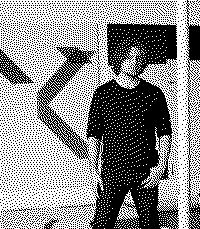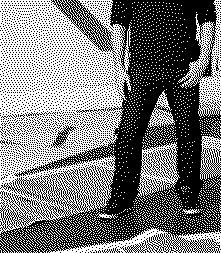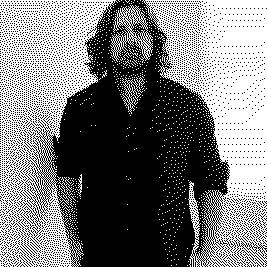Artists/Wade Guyton
Fast Facts
Innovator of Digital Printing
Wade Guyton revolutionizes the use of inkjet printers by creating artworks that challenge traditional painting techniques. He is known for his unconventional method of feeding linen or canvas through inkjet printers, embracing the incidental marks and errors as integral parts of his artwork.
Accidental Aesthetics
Guyton's art is characterized by the embrace of accidents and imperfections that occur during the printing process. Smudges, streaks, and misalignments caused by manually feeding materials through printers become distinctive features of his work, highlighting the unpredictability of technology.
Repetition and Seriality
He frequently employs repetition of symbols and motifs, such as the letter "X" and images of flames, across various pieces. This approach explores themes of duplication, originality, and the impact of digital technologies on the reproduction of images.
Interrogation of Materiality
Through his unique process, Guyton interrogates the materiality of both the digital image and its physical substrate. His work blurs the lines between digital media and traditional painting, questioning the nature of art in the digital age.
Engagement with Art History
Despite his forward-looking use of technology, Guyton's work is deeply engaged with the history of art. He references and reinterprets traditional artistic motifs and practices, situating his work within a broader historical context while simultaneously pushing its boundaries.
Minimalist Aesthetic with Depth
At first glance, Guyton's pieces might seem simple due to their minimalistic use of color and form. However, they possess a conceptual depth that challenges viewers to reconsider the relationship between the method of creation and the final artwork, especially in the context of digital and mechanical reproduction.
Biography



Wade Guyton is a distinguished figure in the contemporary art world, renowned for his innovative approach to painting that integrates digital technologies.
Born in 1972 in Hammond, Indiana, Guyton has reshaped the landscape of modern art by challenging traditional techniques and mediums. His signature method involves running linen canvases through inkjet printers, embracing the glitches and imperfections that arise from this process. These perceived flaws become unique features of his work, distinguishing each piece with recurrent motifs such as geometric stripes, circles, flames, and the letters 'U' and 'X'. Guyton's exploration extends beyond canvases to incorporate modern digital elements like screenshots and camera phone snapshots, reflecting on the relationship between technology and art.
Guyton's collaboration with fellow artist Kelley Walker under the name Guyton\Walker since 2004 is a testament to his penchant for innovation. Together, they create vibrant, layered images on three-dimensional objects, integrating elements of consumer culture and advertising. This partnership highlights Guyton's interest in the interaction between digital imagery and physical objects, a theme that permeates much of his work.
He has been honored with several prestigious awards throughout his career, including the American Academy of Arts and Letters Award in Art (2014) and the Foundation for Contemporary Arts Grants to Artists Award (2004). These accolades acknowledge his contributions to the art world and his role in advancing contemporary artistic practices.
Guyton has held major mid-career solo shows at significant institutions worldwide, such as the Museum Ludwig in Cologne, the Serpentine Gallery in London, and the Whitney Museum of American Art in New York. His works are held in numerous esteemed collections, including the Museum of Modern Art in New York, the Centre Pompidou in Paris, and the Whitney Museum of American Art in New York. Despite the commercial success of his works, Guyton has openly expressed his discomfort with the art market's valuation of art, reflecting on the impact of financial considerations on artistic integrity. (Wikipedia) (Ocula Art).
Importance
Wade Guyton's significance in the contemporary art landscape is multifaceted, encompassing his innovative techniques, influential thematic explorations, and contributions to the discourse of digital and print media within art.
Innovator of Digital and Print Media in Art
Guyton is renowned for his groundbreaking use of digital technologies, particularly inkjet printers, as a means of creating art. By running linen canvases through these printers, he embraces and incorporates the inherent glitches and imperfections into his work. This process challenges traditional painting techniques and questions the role of the artist's hand in the digital age.
Contributions to the Dialogue on Contemporary Art
Guyton's work stands at the forefront of discussions about the intersection of technology and art. Through his use of common digital symbols, such as the letters 'X' and 'U', and incorporation of screenshots and digital imagery, he reflects on how digital media shapes our perception of art and culture. His approach offers a critical examination of the reproduction and dissemination of images in the digital era.
Reinterpretation of Abstract and Minimalist Traditions
Guyton is part of a generation of artists revisiting and redefining late Modernist approaches to art, particularly abstraction and minimalism, through the lens of 21st-century digital technology. His work, while abstract and minimalist in nature, is deeply infused with the technological processes that define its creation, offering a contemporary take on these artistic movements.
Influential Collaborations and Collective Projects
Collaborating with artists like Kelley Walker and operating the Leopard Press, Guyton has contributed significantly to the collective and collaborative aspects of art-making. These partnerships have explored the boundaries between individual and shared artistic production, as well as the impact of digital and print media on contemporary art.
Critical Engagement with the Art Market
Guyton's works, which have garnered significant attention in the art market, also serve as a commentary on the commercial aspects of the art world. His response to the auctioning of his works for high prices, by producing multiple copies to question their value, highlights his critical stance on the commodification of art.
Extensive Exhibition History and Collection Presence
With solo shows at major institutions like the Whitney Museum of American Art and inclusion in significant public and private collections worldwide, Guyton's impact on the field is indisputable. His works resonate with a broad audience and continue to influence contemporary artistic practices and dialogues.
Recognition and Awards
Guyton's receipt of prestigious awards and grants underscores his contributions to contemporary art. These accolades reflect the art community's acknowledgment of his innovative techniques and critical exploration of digital media's role in art.
Technique
Wade Guyton's artistic technique is characterized by a unique fusion of digital processes and traditional art forms, representing a pioneering approach to contemporary art creation.
Use of Inkjet Printers on Linen
At the core of Guyton's practice is his innovative use of commercial inkjet printers to apply imagery directly onto linen. This process, which involves running the fabric through the printer multiple times, embraces the incidental marks, streaks, and misalignments that occur, integrating these "errors" as integral components of the final artwork. This method challenges traditional painting techniques by introducing a mechanical process into the creation of art, thereby questioning the role of the artist's hand in the era of digital reproduction.
Digital Imagery and Typography as Subject Matter
Guyton frequently utilizes digital icons, such as the letters 'X' and 'U', geometric shapes, and screenshots from websites, as the primary imagery in his work. These symbols, chosen for their ubiquity in digital culture, are transformed through repetition, scale, and context, acquiring new meanings and questioning the relationship between digital information and physical space.
Exploration of Materiality and Medium
Despite employing digital printing technology, Guyton's work is deeply engaged with the materiality of painting. The texture of the linen, the physicality of the ink, and the interaction between the medium and the substrate play crucial roles in the outcome of each piece. This focus on materiality brings his work into dialogue with traditional painting, even as it diverges from it in method and execution.
Collaborative Processes
Guyton's technique also extends into collaborative realms, particularly in his projects with Kelley Walker and other artists. These collaborations often explore the extension of his printing techniques onto other media and objects, such as sculptures, installations, and three-dimensional canvases, further blurring the lines between different art forms.
Critical Engagement with Reproduction and Distribution
A key aspect of Guyton's technique is his critical stance on the reproduction and distribution of artworks in the digital age. By deliberately reproducing his own works and disseminating them online, Guyton engages in a critique of the uniqueness and authenticity of art objects, challenging traditional notions of value and originality in the art market.
Integration of Biographical and Studio Elements
In his more recent works, Guyton has begun to incorporate elements drawn directly from his personal and studio environment, including photographs of his studio space and objects within it. This shift marks a deeper exploration of the relationship between the digital and the personal, the public and the private, in the creation of art.











